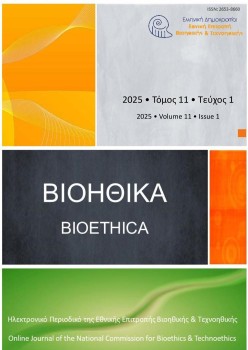Παιδιατρική Εν τω Βάθει Εγκεφαλική Διέγερση για Θεραπεία και Ενίσχυση του Εγκεφάλου: Ηθικές, Κλινικές και Νομικές Διαστάσεις

Περίληψη
Η εν τω βάθει εγκεφαλική διέγερση (DBS) εφαρμόζεται παραδοσιακά σε ενήλικες για τη θεραπεία ορισμένων νευρολογικών και ψυχιατρικών διαταραχών. Πέρα από τους ενήλικες, μπορεί επίσης να χρησιμοποιηθεί σε παιδιά, αλλά οι εφαρμογές της στην παιδιατρική είναι περιορισμένες. Ένα καινοτόμο σενάριο αναφορικά με το μέλλον της DBS είναι η εφαρμογή της πέρα από το κομμάτι της αποκατάστασης της ανθρώπινης υγείας, στον τομέα της ενίσχυσης του εγκεφάλου. Ωστόσο, οι καινούργιες εφαρμογές της DBS παρουσιάζουν σοβαρά ηθικά, κλινικά και νομικά ζητήματα, τα οποία εξετάζονται στην παρούσα εργασία.
Αρχικά, παρουσιάζονται οι εφαρμογές της παιδιατρικής DBS, μαζί με τις δυνητικές βραχυπρόθεσμες και μακροπρόθεσμες επιδράσεις της. Στη συνέχεια, αναλύεται ο έννοια της "ενίσχυσης του εγκεφάλου", σε αντιδιαστολή με τη "θεραπεία", και ο πιθανός ρόλος της παιδιατρικής DBS σε αυτόν τον τομέα. Προχωρώντας στα ηθικά ζητήματα της παιδιατρικής DBS, καλύπτεται μία ευρεία γκάμα θεμάτων, μεταξύ των οποίων είναι τα ζητήματα ασφάλειας, η αυθεντικότητα, η λήψη αποφάσεων και οι κοινωνικές ανησυχίες. Στην ενότητα των κλινικών διαστάσεων, επισημαίνεται η σημασία της διεξαγωγής σχετικών κλινικών δοκιμών, καθώς και οι προκλήσεις που αντιμετωπίζονται. Στη συνέχεια, εξετάζεται το νομικό πλαίσιο των συσκευών DBS, με την παράθεση κανονισμών τόσο για ιατρικές όσο και για μη ιατρικές συσκευές, ανάλογα με τη συγκεκριμένη εφαρμογή της DBS. Αυτές οι συζητήσεις αποτελούν προετοιμασία για την παρουσίαση συστάσεων, από ηθική, κλινική και νομική άποψη.
Ο απώτερος στόχος της εργασίας είναι να παρέχει μονοπάτια για την ευθυγράμμιση της επιστημονικής προόδου με την ευζωία των παιδιών.
Λεπτομέρειες άρθρου
- Πώς να δημιουργήσετε Αναφορές
-
Μηνάγια Μ. (2025). Παιδιατρική Εν τω Βάθει Εγκεφαλική Διέγερση για Θεραπεία και Ενίσχυση του Εγκεφάλου: Ηθικές, Κλινικές και Νομικές Διαστάσεις. Βιοηθικά, 11(1), 36–50. https://doi.org/10.12681/bioeth.40930
- Ενότητα
- Ανασκοπήσεις

Αυτή η εργασία είναι αδειοδοτημένη υπό το CC Αναφορά Δημιουργού 4.0.
Οι Συγγραφείς που δημοσιεύουν εργασίες τους σε αυτό το περιοδικό συμφωνούν στους παρακάτω όρους:
- Οι Συγγραφείς διατηρούν τα Πνευματικά Δικαιώματα και χορηγούν στο περιοδικό το δικαίωμα της πρώτης δημοσίευσης, ενώ ταυτόχρονα τα πνευματικά δικαιώματα της εργασίας προστατεύονται σύμφωνα με την Creative Commons Attribution CC BY 4.0, που επιτρέπει άμεση πρόσβαση στις εργασίες και κάθε χρήστη να διαβάζει, να κάνει λήψη, να αντιγράφει, να διανέμει, να εκτυπώνει, να αναζητά, ή να συνδέει με το πλήρες περιεχόμενο των άρθρων, να τα αναζητά για ευρετηρίαση, να τα χρησιμοποιεί ως δεδομένα σε λογισμικό, ή να τα χρησιμοποιεί για οποιοδήποτε άλλο νόμιμο σκοπό. Προϋπόθεση ε΄ιναι η αναφορά στον αρχικό δημιουργό/ούς και την αρχική δημοσίευση σε αυτό το περιοδικό.
- Οι Συγγραφείς μπορούν να συνάπτουν ξεχωριστές, και πρόσθετες συμβάσεις και συμφωνίες για την μη αποκλειστική διανομή της εργασίας όπως δημοσιεύτηκε στο περιοδικό αυτό (π.χ. κατάθεση σε ένα ακαδημαϊκό καταθετήριο ή δημοσίευση σε ένα βιβλίο), με την προϋπόθεση της αναγνώρισης και την αναφοράς της πρώτης δημοσίευσης σε αυτό το περιοδικό.
Το περιοδικό Βιοηθικά επιτρέπει και ενθαρρύνει τους συγγραφείς να καταθέτουν τα δημοσιευμένα άρθρα σε θεσμικά (π.χ. το αποθετήριο του Εθνικού Κέντρου Τεκμηρίωσης) ή θεματικά αποθετήρια (π.χ. αποθετήριο SSOAR για τις Κοινωνικές Επιστήμες), μετά τη δημοσίευσή τους στο περιοδικό «Βιοηθικά» και με όρους Ανοικτής Πρόσβασης, όπως κατά περίπτωση προσδιορίζονται από τους χρηματοδότες της έρευνάς τους ή/και τα ιδρύματα με τα οποία συνεργάζονται.
Κατά την κατάθεση της εργασίας τους, οι συγγραφείς πρέπει να παρέχουν πληροφορίες σχετικά με τη δημοσίευση του άρθρου στο περιοδικό «Βιοηθικά» και τις πηγές χρηματοδότησης της έρευνάς τους.
Κατάλογοι των ιδρυματικών και θεματικών αποθετηρίων ανά χώρα υπάρχουν στη βάση http://opendoar.org/countrylist.php . Οι συγγραφείς έχουν τη δυνατότητα να καταθέσουν χωρίς κόστος την εργασία τους στο αποθετήριο www.zenodo.org, το οποίο υποστηρίζεται από το OpenAIRE (www.openaire.eu ), στο πλαίσιο των πολιτικών της Ευρωπαϊκής Επιτροπής για την ενίσχυση της Ανοικτής ακαδημαϊκής έρευνας.


